Choosing the Best Email Buddy – Drip vs TinyEmail
Ever wondered which tool can supercharge your email game? Today, we’re diving into the world of email marketing with a focus on two major players: Drip and TinyEmail. Imagine it as picking the coolest sidekick for your business emails. We’ll chat about pricing, how easy they are to use, the fancy things they can do, and more. By the end, you’ll know which one fits your business like a glove. Let’s make your emails awesome!
- Drip vs TinyEmail – Pricing Structure Comparison
- Drip vs TinyEmail – User Interface and Ease of Use Comparison
- Drip vs TinyEmail – Automation Capabilities Unveiled
- Drip vs TinyEmail – Integration Options Explored
- Drip vs TinyEmail – Email Design and Templates Evaluation
- Drip vs TinyEmail – Navigating Customer Support and Resources
- Drip vs TinyEmail – Unveiling Analytics and Reporting Capabilities
- Drip vs TinyEmail – Scaling Up: Assessing Scalability and Flexibility
- Drip vs TinyEmail – Ensuring Security and Compliance
- Conclusion: Making the Right Choice for Your Email Marketing Success
Drip vs TinyEmail – Pricing Structure Comparison
When embarking on the journey of selecting an email marketing platform, understanding the pricing structure is a crucial step. In this comprehensive guide, we’ll dissect the pricing models of two popular contenders, Drip and TinyEmail, to help you make an informed decision for your business.
1. Drip’s Pricing Structure:
Drip adopts a tiered pricing model, allowing businesses to choose a plan that aligns with their needs and scale. Here’s a breakdown of the key features:
- Basic Plan: Designed for beginners, it offers essential features at an affordable rate.
- Pro Plan: Geared towards growing businesses, this plan unlocks advanced automation and customization.
- Enterprise Plan: Tailored for large enterprises, it provides high-level features and personalized support.
Drip’s pricing is based on the number of subscribers, making it scalable as your email list expands. It offers a 14-day free trial, enabling users to explore the platform’s features before committing.
2,500 people in your email list:
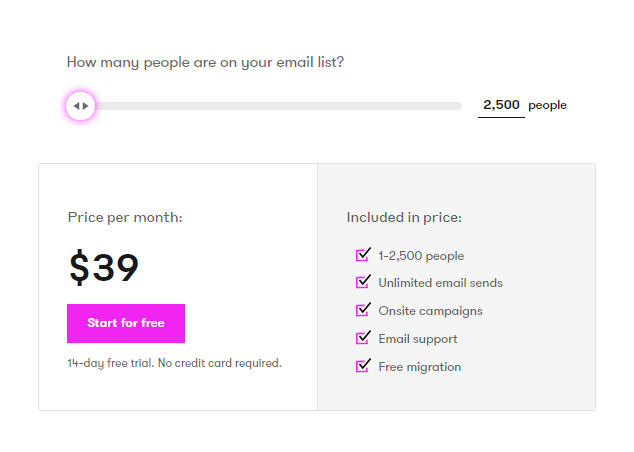
10,000 people in your email list:
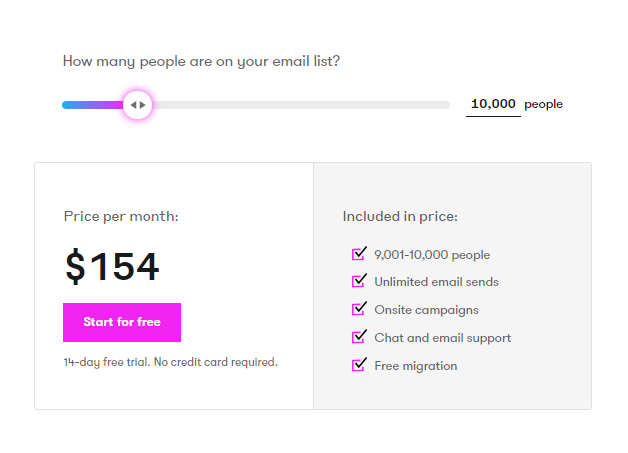
2. TinyEmail’s Pricing Structure:
TinyEmail, on the other hand, adopts a simpler approach with straightforward pricing tiers. Let’s delve into the details:
- Starter Plan: Ideal for small businesses and startups, offering core features at an economical rate.
- Business Plan: Catering to growing businesses, this plan introduces advanced automation and customization.
- Enterprise Plan: Tailored for large-scale enterprises, providing top-tier features and dedicated support.
TinyEmail’s pricing is also based on the number of subscribers, ensuring flexibility as your business expands. Additionally, they offer a free trial period for users to explore the platform’s capabilities. For more information, explore a TinyEmail review.
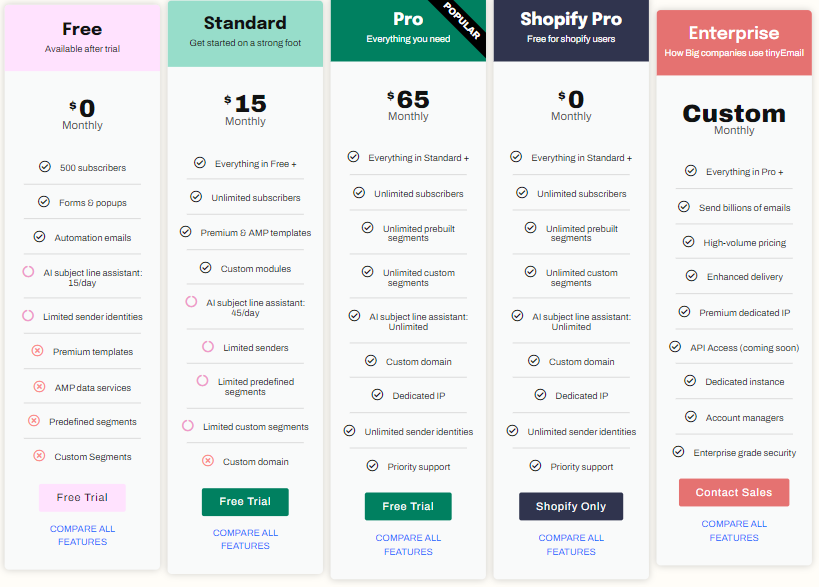
3. Comparative Analysis:
Now, let’s compare the two platforms:
- Drip’s tiered pricing is beneficial for businesses at different stages, offering scalability.
- TinyEmail’s straightforward pricing simplifies decision-making, especially for smaller businesses.
Conclusion: Drip vs TinyEmail
In the sphere of email marketing, both Drip and TinyEmail present viable options. When assessing the pricing structures, consider your business’s current needs and potential growth. Drip’s tiered model may appeal to those seeking scalability, while TinyEmail’s simplicity might be attractive for those valuing straightforward pricing.
Remember to check for any updates or changes in pricing structures, as these details can evolve over time. Stay tuned for more insights as we delve deeper into the comparison between Drip and TinyEmail.
Drip vs TinyEmail – User Interface and Ease of Use Comparison
When navigating the realm of email marketing, a user-friendly interface can significantly impact your workflow. Let’s dissect the user interface and ease of use for two prominent platforms, Drip and TinyEmail, helping you choose the one that aligns seamlessly with your business needs.
1. Drip’s User Interface:
Drip boasts an intuitive and visually appealing interface, designed to cater to both beginners and experienced marketers. Key features include:
- Dashboard: The dashboard provides a comprehensive overview of your campaigns, subscriber activity, and automation workflows.
- Drag-and-Drop Editor: Creating visually stunning emails is made easy with Drip’s drag-and-drop editor.
- Navigation: The menu structure is logical and straightforward, allowing users to navigate effortlessly between features.
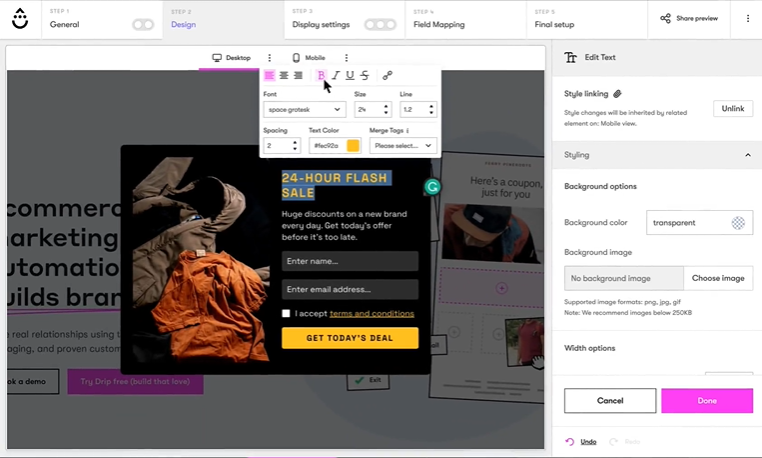
2. TinyEmail’s User Interface:
TinyEmail focuses on simplicity without compromising functionality. Here’s a glimpse of its user interface:
- Clean Design: The interface is uncluttered, emphasizing a minimalist approach for a seamless user experience.
- Easy Campaign Setup: TinyEmail streamlines the process of creating campaigns, making it accessible for users of all skill levels.
- Quick Navigation: The platform ensures quick access to essential features, promoting an efficient workflow.
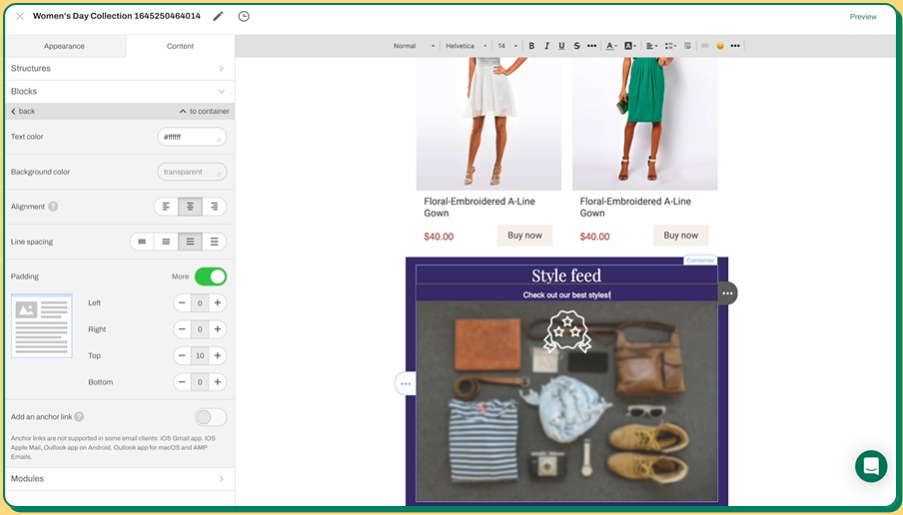
3. Comparative Analysis:
- Drip’s feature-rich interface suits businesses with diverse needs, offering a balance between power and simplicity.
- TinyEmail excels in straightforwardness, ideal for users who prioritize an uncomplicated and efficient experience.
Conclusion: Drip vs TinyEmail
Both Drip and TinyEmail recognize the significance of a user-friendly interface. When choosing between them, consider your team’s proficiency level and the complexity of your email marketing strategy. Drip’s comprehensive features might be a boon for those seeking versatility, while TinyEmail’s simplicity could be an advantage for those valuing a streamlined user experience.
Stay tuned as we delve deeper into the comparison between Drip and TinyEmail, exploring various facets to guide you in making the right choice for your business.
Drip vs TinyEmail – Automation Capabilities Unveiled
In the dynamic landscape of email marketing, the ability to automate campaigns and workflows can significantly elevate your efficiency. Let’s unravel the automation capabilities of two prominent platforms, Drip and TinyEmail, empowering you to make an informed decision for your business.
1. Drip’s Automation Features:
Drip takes automation to a sophisticated level, offering a range of features to tailor your campaigns. Key highlights include:
- Workflow Builder: Drip’s visual workflow builder simplifies the creation of intricate automation sequences, allowing for personalized customer journeys.
- Behavior Triggers: Automate responses based on subscriber actions, such as clicks, opens, or purchases.
- Dynamic Content: Tailor your emails dynamically based on subscriber behavior and preferences.
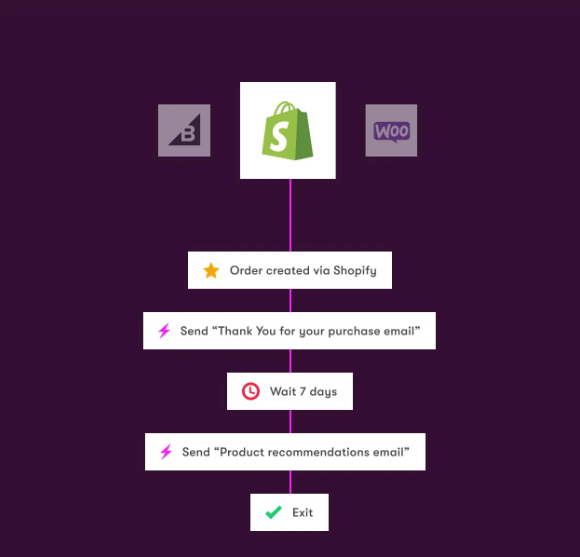
2. TinyEmail’s Automation Features:
TinyEmail, while maintaining simplicity, provides robust automation capabilities. Here’s a glimpse of what it offers:
- Automated Campaigns: Easily set up automated email campaigns for various scenarios, such as welcome sequences or abandoned cart reminders.
- Personalization: TinyEmail allows for basic personalization, automating emails based on subscriber data.
- Triggered Emails: Send emails based on specific triggers like subscriber sign-ups or specific dates.
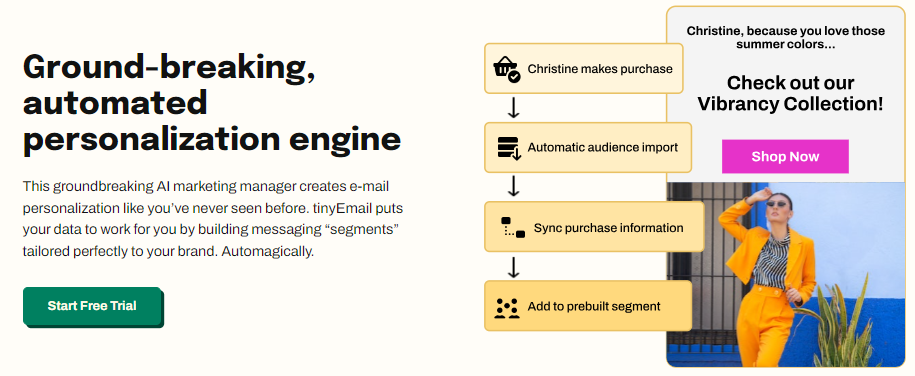
3. Comparative Analysis:
- Drip’s advanced automation features cater to businesses with intricate marketing strategies and a need for highly personalized communication.
- TinyEmail provides solid automation for businesses seeking efficiency without delving into complex workflows.
Conclusion: Drip vs TinyEmail
The automation capabilities of Drip and TinyEmail offer solutions for a spectrum of business needs. If your strategy requires intricate workflows and deep personalization, Drip may be the preferred choice. Conversely, TinyEmail excels in providing automation that is easy to set up and manage, making it suitable for businesses seeking efficiency without extensive customization.
Stay tuned as we continue our exploration of the Drip vs TinyEmail comparison, unraveling more aspects to aid you in selecting the ideal platform for your email marketing endeavors.
Drip vs TinyEmail – Integration Options Explored
The ability of an email marketing platform to seamlessly integrate with other tools is vital for a cohesive and efficient workflow. Join us as we dissect the integration options of two major players, Drip and TinyEmail, to help you make an informed choice for your business.
1. Drip’s Integration Capabilities:
Drip offers an extensive array of integrations, enhancing its versatility and compatibility with various business tools. Key points include:
- E-commerce Platforms: Drip integrates seamlessly with popular e-commerce platforms, facilitating the synchronization of customer data and purchase history.
- CRM Systems: Connect Drip with your CRM system to consolidate customer information and streamline communication.
- Analytics Tools: Integrate Drip with analytics tools to gather insights into campaign performance and subscriber behavior.
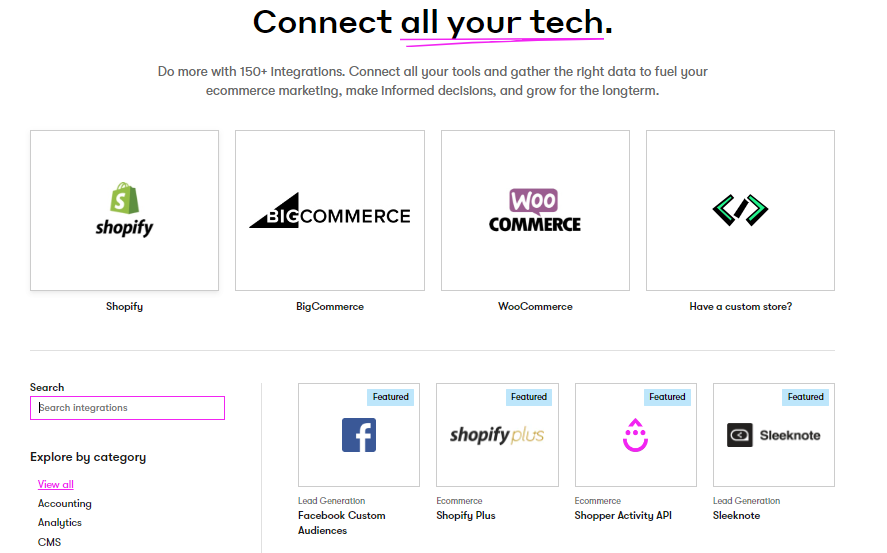
2. TinyEmail’s Integration Capabilities:
TinyEmail, while maintaining simplicity, provides essential integrations to support your email marketing efforts. Here’s a glimpse of its integration options:
- Basic E-commerce Integrations: TinyEmail integrates with key e-commerce platforms for basic customer data synchronization.
- CRM Connectivity: Connect TinyEmail with your CRM system to ensure smooth data flow between platforms.
- Social Media Platforms: Integrate TinyEmail with social media for cohesive marketing strategies.
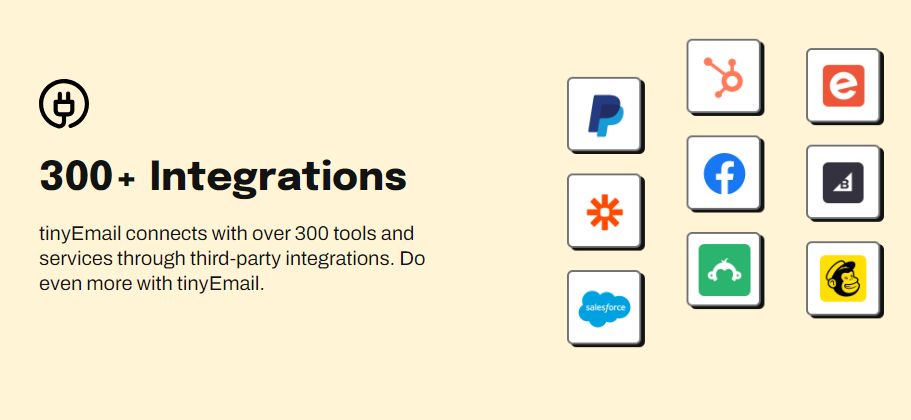
3. Comparative Analysis:
- Drip’s extensive integration options cater to businesses with complex tech stacks and a need for comprehensive data synchronization.
- TinyEmail, with a focus on simplicity, provides essential integrations suitable for businesses seeking a streamlined approach.
Conclusion: Drip vs TinyEmail
When deciding between Drip and TinyEmail, consider the integration needs of your business. Drip’s broad range of integrations may be advantageous for those with intricate workflows, while TinyEmail provides ample support for essential integrations, making it suitable for businesses with simpler requirements.
Continue following our exploration of the Drip vs TinyEmail comparison as we delve into more aspects to guide you in selecting the ideal platform for your email marketing endeavors.
Drip vs TinyEmail – Email Design and Templates Evaluation
In the realm of email marketing, the visual appeal and design of your emails play a pivotal role in capturing your audience’s attention. Let’s explore the email design and template offerings of two major players, Drip and TinyEmail, aiding you in making an informed choice for your business.
1. Drip’s Email Design Features:
Drip excels in providing a robust set of tools for crafting visually stunning emails. Key features include:
- Drag-and-Drop Editor: Drip’s user-friendly editor allows for effortless customization, making it accessible for users with varying design skills.
- Responsive Design: Ensure your emails look great on any device with Drip’s responsive design options.
- Template Library: Drip offers a diverse library of professionally designed templates, covering various industries and purposes.

2. TinyEmail’s Email Design Features:
TinyEmail, while maintaining simplicity, provides tools for creating visually appealing emails. Here’s a glimpse of its design features:
- Easy Editing Interface: TinyEmail’s straightforward editor allows for quick and easy customization of email content.
- Basic Templates: Choose from a selection of basic, clean templates suitable for various types of emails.
- Customization Options: While not as extensive as Drip, TinyEmail offers enough customization options for users looking to personalize their emails.
- AI-powered Messaging: With tinyAlbert AI you can combine your proprietary data with powerful machine learning and double your email open rate.
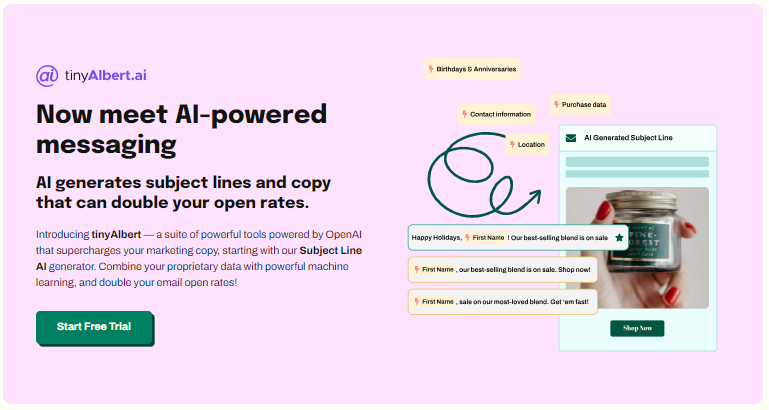
3. Comparative Analysis:
- Drip’s extensive design features cater to businesses with a focus on creating visually sophisticated and customized emails.
- TinyEmail provides simplicity and efficiency in design, suitable for businesses that prioritize a straightforward approach.
Conclusion: Drip vs TinyEmail
Consider your design needs and the proficiency of your team when choosing between Drip and TinyEmail. Drip’s advanced features are ideal for those seeking intricate and customized designs, while TinyEmail’s simplicity suits businesses that value efficiency without extensive design customization.
Stay tuned for more insights as we continue our exploration of the Drip vs TinyEmail comparison, helping you navigate the landscape of email marketing platforms.
Drip vs TinyEmail – Navigating Customer Support and Resources
When embarking on your email marketing journey, having reliable customer support and accessible resources can make a significant difference. Let’s delve into the customer support and resource offerings of two major players, Drip and TinyEmail, aiding you in making an informed decision for your business.
1. Drip’s Customer Support:
Drip takes pride in offering robust customer support, ensuring users have assistance when needed. Key support features include:
- 24/7 Support: Drip provides around-the-clock support for users, ensuring help is available whenever it’s required.
- Knowledge Base: A comprehensive knowledge base is available, offering guides, tutorials, and FAQs to assist users independently.
- Dedicated Account Managers: Larger plans come with the added benefit of having a dedicated account manager for personalized assistance.
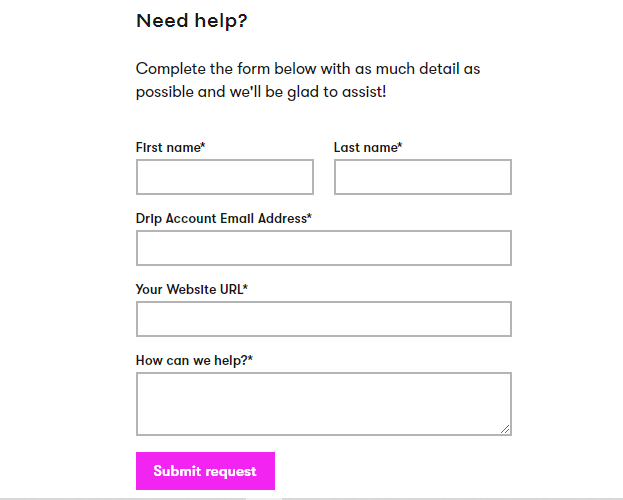
2. TinyEmail’s Customer Support:
TinyEmail, while maintaining simplicity, offers accessible customer support to assist users. Here’s a glimpse of its support features:
- Email Support: Users can reach out to TinyEmail’s support team via email for assistance.
- Knowledge Base: TinyEmail provides a knowledge base with guides and articles to help users navigate common issues independently.
- Community Forums: Engage with other TinyEmail users and seek advice or solutions through community forums.

3. Comparative Analysis:
- Drip’s 24/7 support and dedicated account managers cater to businesses that prioritize immediate and personalized assistance.
- TinyEmail’s accessible email support and community forums suit businesses looking for straightforward help and community engagement.
Conclusion: Drip vs TinyEmail
Consider the level of support your team requires when choosing between Drip and TinyEmail. Drip’s comprehensive support structure is beneficial for those who need immediate assistance and dedicated account management. In contrast, TinyEmail’s accessible support channels are suitable for businesses that value simplicity and community engagement.
As we progress through our exploration of the Drip vs TinyEmail comparison, stay tuned for more insights to guide you in selecting the ideal platform for your email marketing endeavors.
Drip vs TinyEmail – Unveiling Analytics and Reporting Capabilities
Understanding the performance of your email campaigns is crucial for refining strategies and maximizing impact. Let’s delve into the analytics and reporting features of two major players, Drip and TinyEmail, to empower you in making an informed decision for your business.
1. Drip’s Analytics and Reporting:
Drip offers robust analytics tools to provide insights into your email campaigns. Key features include:
- Detailed Metrics: Drip provides comprehensive data on open rates, click-through rates, and other key performance indicators (KPIs).
- Conversion Tracking: Track the success of your campaigns by monitoring conversions and attributing them to specific emails.
- Segmentation Reports: Understand subscriber behavior through segmentation reports, allowing for targeted and personalized campaigns.
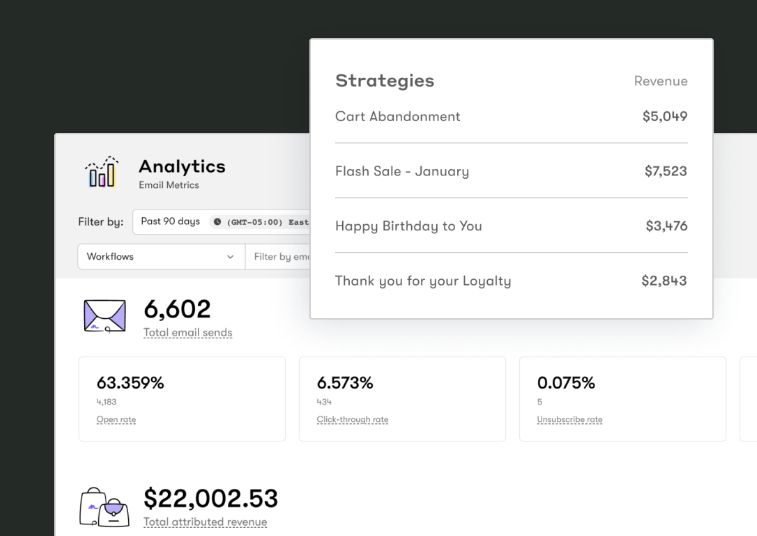
2. TinyEmail’s Analytics and Reporting:
TinyEmail, while maintaining simplicity, offers essential analytics features to monitor campaign performance. Here’s a glimpse of its reporting capabilities:
- Basic Metrics: TinyEmail provides insights into essential metrics like open rates and click-through rates.
- Campaign Comparison: Compare the performance of different campaigns to identify trends and areas for improvement.
- Subscriber Engagement Reports: Understand how subscribers engage with your emails over time.
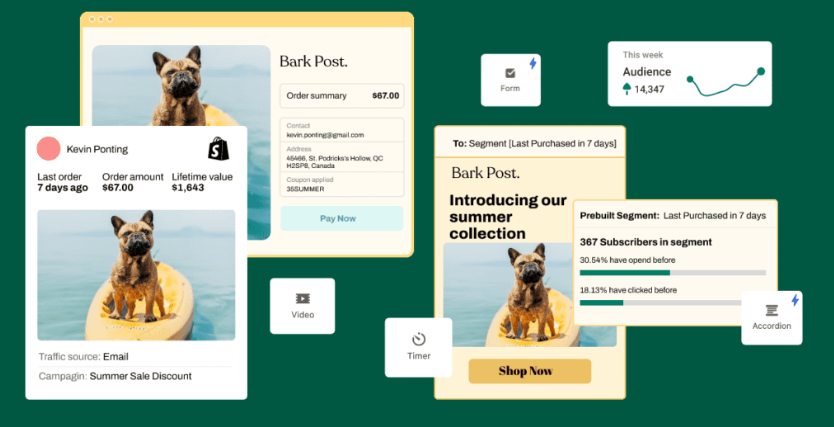
3. Comparative Analysis:
- Drip’s detailed analytics cater to businesses that require in-depth insights for refining and optimizing complex email campaigns.
- TinyEmail’s straightforward reporting is ideal for businesses seeking essential metrics without the complexity of advanced analytics.
Conclusion: Drip vs TinyEmail
Consider the level of analytics detail your business requires when choosing between Drip and TinyEmail. Drip’s comprehensive analytics are beneficial for those with intricate campaign strategies, while TinyEmail’s simplicity suits businesses seeking essential insights without the need for detailed analytics.
Stay tuned for more insights as we continue our exploration of the Drip vs TinyEmail comparison, guiding you in selecting the optimal platform for your email marketing endeavors.
Drip vs TinyEmail – Scaling Up: Assessing Scalability and Flexibility
As your business expands, your email marketing platform’s ability to scale and adapt becomes crucial. Let’s explore the scalability and flexibility features of two major players, Drip and TinyEmail, aiding you in making an informed decision for your evolving business needs.
1. Drip’s Scalability and Flexibility:
Drip is designed with scalability in mind, offering features to accommodate businesses of various sizes. Key points include:
- Tiered Plans: Drip’s tiered pricing model allows businesses to scale up gradually, choosing plans that align with their growing needs.
- Advanced Features: As your email marketing strategy evolves, Drip provides advanced features and customization options to maintain flexibility.
- API Access: Drip’s API access facilitates integration with other tools, enhancing overall flexibility for businesses with unique requirements.
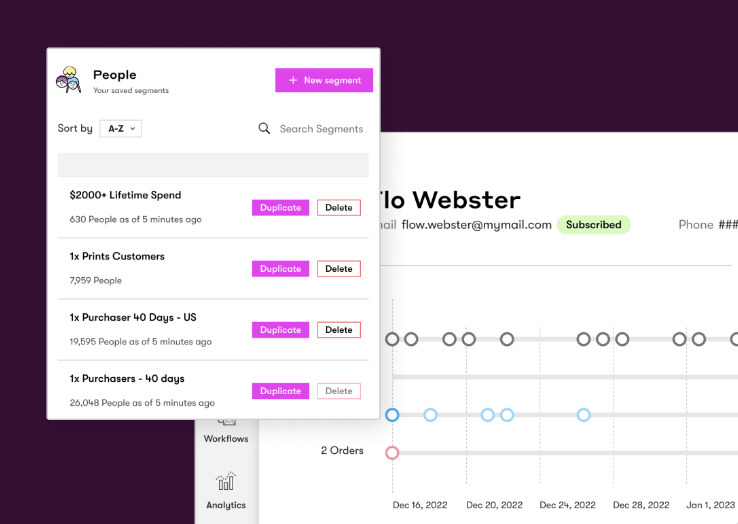
2. TinyEmail’s Scalability and Flexibility:
TinyEmail, while maintaining simplicity, offers scalability features suitable for growing businesses. Here’s a glimpse of its capabilities:
- Straightforward Plans: TinyEmail’s plans are designed for simplicity, making it easy for businesses to scale up without the complexities of tiered pricing.
- Essential Features: While not as advanced as Drip, TinyEmail provides essential features that scale with the needs of growing businesses.
- User-Friendly Interface: TinyEmail’s user-friendly interface ensures scalability without sacrificing ease of use.
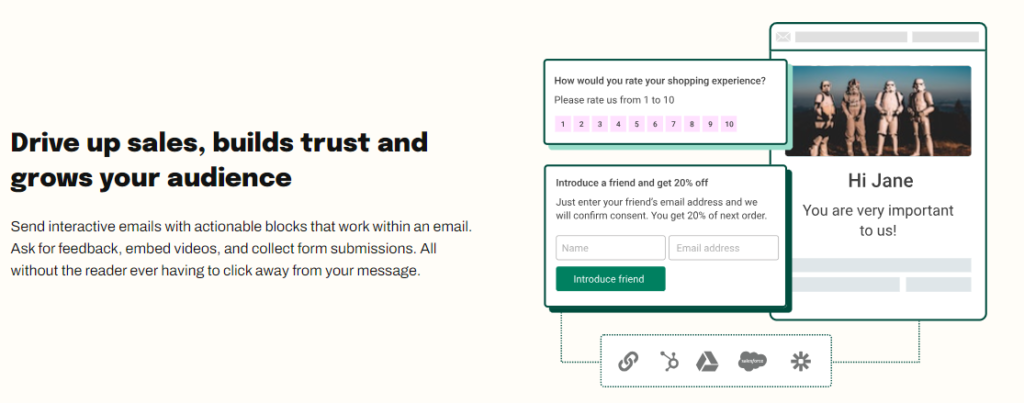
3. Comparative Analysis:
- Drip’s tiered plans and advanced features cater to businesses with complex and scalable email marketing strategies.
- TinyEmail’s simplicity in plan structure and essential features make it a flexible choice for businesses seeking straightforward scalability.
Conclusion:
When considering scalability and flexibility, think about the trajectory of your business. Drip’s tiered plans and advanced features are advantageous for businesses with intricate strategies, while TinyEmail’s simplicity and essential features suit those valuing straightforward scalability.
As we continue our exploration of the Drip vs TinyEmail comparison, stay tuned for more insights to guide you in selecting the ideal platform for your evolving email marketing needs.
Drip vs TinyEmail – Ensuring Security and Compliance
In the digital landscape, the security of your email marketing platform is paramount. Let’s delve into the security and compliance features of two major players, Drip and TinyEmail, helping you make an informed decision for safeguarding your valuable data.
1. Drip’s Security and Compliance Measures:
Drip prioritizes the protection of user data with robust security features and compliance adherence. Key aspects include:
- Data Encryption: Drip employs advanced encryption protocols to secure data transmission and storage.
- Compliance with Regulations: Drip adheres to industry standards and regulations, ensuring compliance with data protection laws.
- Access Controls: Drip provides tools for controlling user access, limiting permissions to enhance data security.
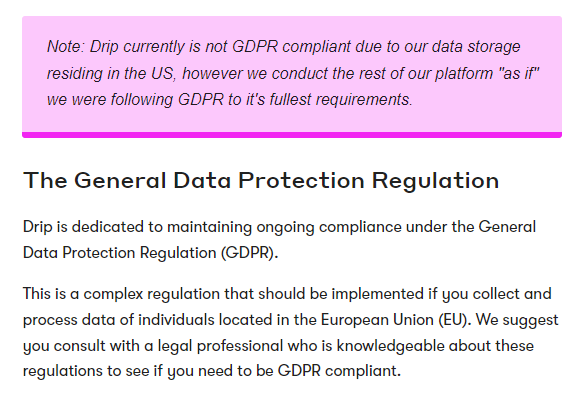
2. TinyEmail’s Security and Compliance Measures:
TinyEmail, while maintaining simplicity, takes measures to ensure the security and compliance of user data. Here’s an overview:
- Secure Data Transmission: TinyEmail uses secure protocols for data transmission to protect information during transit.
- Regulatory Compliance: TinyEmail complies with data protection regulations, ensuring user data is handled in accordance with legal requirements.
- User Authentication: TinyEmail implements secure authentication processes to prevent unauthorized access.
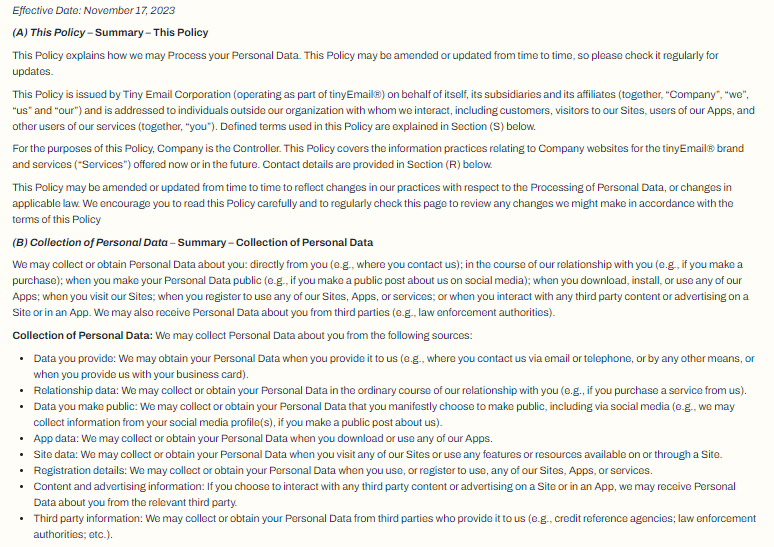
3. Comparative Analysis:
- Drip’s advanced security features and compliance measures are suitable for businesses handling sensitive data and requiring strict adherence to regulations.
- TinyEmail, with a focus on simplicity, provides essential security measures, making it suitable for businesses with straightforward security requirements.
Conclusion:
Evaluate your business’s security needs when choosing between Drip and TinyEmail. Drip’s advanced security features cater to businesses with stringent security and compliance requirements, while TinyEmail’s simplicity and essential security measures are suitable for businesses with straightforward needs.
Stay tuned for more insights as we continue our exploration of the Drip vs TinyEmail comparison, guiding you in selecting the platform that aligns with your security and compliance priorities.
Conclusion: Making the Right Choice for Your Email Marketing Success
In our exploration of Drip vs TinyEmail, we’ve delved into key aspects that shape the landscape of email marketing. Now, as you stand at the crossroads of choosing the ideal platform for your business, let’s recap the essential considerations.
- Pricing Structure: Drip’s tiered plans offer scalability, while TinyEmail’s straightforward pricing caters to simplicity.
- User Interface and Ease of Use: Drip’s intuitive design suits both beginners and experts, while TinyEmail excels in simplicity for efficient use.
- Automation Capabilities: Drip’s advanced automation features cater to intricate workflows, while TinyEmail provides efficiency with simpler automation.
- Integration Options: Drip’s extensive integrations support complex tech stacks, while TinyEmail offers essential integrations for streamlined processes.
- Email Design and Templates: Drip’s robust design features suit businesses aiming for sophisticated and customized emails, while TinyEmail provides simplicity with efficient design tools.
- Customer Support and Resources: Drip’s 24/7 support and dedicated account managers offer immediate and personalized assistance, while TinyEmail’s accessible support channels suit straightforward needs.
- Analytics and Reporting: Drip’s detailed analytics are ideal for businesses with intricate campaign strategies, while TinyEmail’s simplicity suits those seeking essential insights.
- Scalability and Flexibility: Drip’s tiered plans and advanced features are beneficial for complex strategies, while TinyEmail’s simplicity suits straightforward scalability.
- Security and Compliance: Drip’s advanced security features cater to stringent requirements, while TinyEmail’s simplicity and essential measures are suitable for straightforward needs.
In your decision-making process, align these factors with your business goals, size, and preferences. Drip offers versatility for businesses with complex demands, while TinyEmail provides simplicity for those valuing straightforward solutions.
Remember, the success of your email marketing endeavors lies in selecting a platform that aligns seamlessly with your unique requirements. As you embark on this journey, stay tuned for more insights and updates to guide you in optimizing your email marketing strategy.
Choose wisely, and may your email campaigns thrive!
RELATED:
ActiveCampaign vs TinyEmail – Choosing the best Email Marketing
Aweber vs TinyEmail – Unveiling the Ultimate Email Marketing Champion


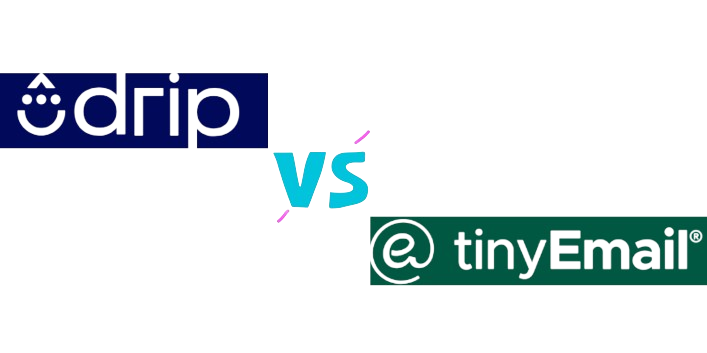



Pingback: Mailchimp vs TinyEmail: 13 Comprehensive Comparisons for a Winning Strategy
Pingback: TinyEmail Review: 13 Breakthrough Features Transforming Email Marketing
Pingback: ActiveCampaign vs Drip: 12 Factors to Consider When Selecting the Best Email Marketing Tool.
Pingback: Email Marketing Automation Tools for Startups: 25 Proven Solutions for Dynamic Engagement
Pingback: Campaign Monitor vs TinyEmail for Your Email Marketing Success: Choose the Best in 2024.